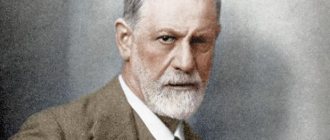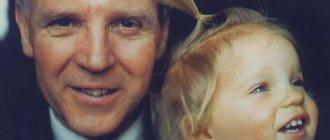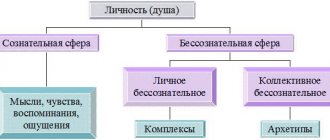Pavlov's school.
The doctrine of conditioned reflexes is a temporary connection between an external agent and the activity of the body.
Unconditioned reflexes are carried out under any conditions. Signaling systems. 1st signaling system - irritation on external receptors and on the cerebral hemispheres, common in humans and animals; The 2nd signal system is the word. Laws of GNI: law of irrationation, law of concentration. He studied experimental neuroses. Orbeli L.D. the doctrine of the 2nd signal system, the problem of labor and inspiration. Anokhin P.K. theory of functional systems, universal model of the brain (afferent synthesis), biology and neurophysiology of the conditioned reflex. Lomov B.F. special developments of instinctive psychology, occupational psychology, psychophysics, mathematics. psychology. Davydov V.V. the phenomenon of interiorization.
Bibliography
- Abulkhanova-Slavskaya K.A. Philosophical and psychological concept of S.L. Rubinstein. Moscow, 1989. 248 pp.
- Kovalev A.G. Psychology of Personality. M., 1970. - 168 p.
- Kon I.S. Sociology of personality. - M., 1967, - 315 PAGE.
- Lazursky A.F. A sketch of the science of character. M., 1995, - 247 S.
- Leontyev A.N. Activity. Consciousness. Personality. M., 1975. - 281 p.
- Maklakov A.G. General psychology. - St. Petersburg, 2000. - 592 p.
- Meshcheryakov B.G., Zinchenko V.P. Large psychological dictionary. - SPS, 2002 - 920 p.
- Myazishev V.N. The concept of personality in the aspects of norm and pathology // Psychology of relations. Selected psychological works. M.-Voronezh, 1995. P. 39-67.
- general psychology: a textbook for students of educational institutions. / Ed. A.V. Petrovsky. - M.: Education, 1986. - 308 p.
- Platonov K.K. Structure and development of personality. M., 1986. - 224 hours.
- psychological science in Russia in the 20th century: Problems of theory and history. M., 1997. - 576 p.
- Rubinshtein S.L. Fundamentals of general psychology. M., 1989. - 268 p.
- Hall K.S., Lindsay G. Theories of personality. M., 1997. - 720 p.
- Hjell L., Ziegler D. Theories of personality. St. Petersburg, 1997. - 796 p.
School of Teplov, Nebylitsyn.
Basic properties and systems according to Pavlov and Nebylitsyn. Blank methods for diagnosing the basic properties of the nervous system and their psychological characteristics.
Properties:
- The strength of nervous processes – irritable and inhibitory.
- Equilibrium of these processes.
- Their mobility.
- Highest plasticity.
Unusual, extraordinary events, irritations of great strength appear in the environment, and, naturally, the need often arises to suppress, delay the effects of these irritations at the request of other, equally or even more powerful external conditions. And nerve cells must endure these extreme stresses of their activity. This also implies the importance of balance, the equality of strength of both nervous processes. Both processes must, so to speak, keep pace with environmental fluctuations, i.e. must have high mobility, the ability to quickly, as required by external conditions, give way, give preference to one irritation over another, irritation before inhibition and vice versa.
The concept of personality of A.V. Petrovsky
Leontiev’s approach to understanding personality found its further development in the works of Russian psychologists - representatives of the Moscow school, including A.N. Petrova. V. Petrovsky. In the textbook “General Psychology,” written under his editorship, there is the following definition of personality: “In psychology, personality is a systemic social quality that an individual acquires in objective activity and communication and which characterizes the level and quality of representation of social relations in an individual.”
A.V. Petrovsky in his developments proceeds from the fact that the concepts of “individual” and “personality” are not identical. Personality is a special characteristic that an individual initially acquires in society in the process of his entry into social relations. In order to understand on what basis certain personality characteristics are formed, it is necessary to consider a person’s life in society. The inclusion of an individual in the system of social relations determines the content and nature of his activities, the scope and methods of communication with other people, that is, the specifics of his social essence, his way of life. But the way of life of individual people, certain communities of people, as well as society as a whole, is determined by the historically developing system of social relations. This means that personality can be understood or studied only in the context of certain social conditions, a certain historical era. In addition, it should be noted that society is not only the external environment for the individual. The individual is constantly involved in a system of social relations mediated by many factors.
Petrovsky believes that the personality of a particular person can continue to live in other people and does not completely die with the death of the person himself. And in the words “he lives in us even after death” there is no mysticism or pure metaphor; this is a statement of the fact of the ideal representation of a person after his material disappearance.
Considering further the views of representatives of the Moscow psychological school on the problem of personality, it should be noted that by the concept of personality, in most cases, the authors meant certain qualities belonging to the individual, and precisely those qualities that determine the uniqueness of a person, his individuality. However, the concepts of “individual”, “personality” and “individuality” are not identical in content - each of them reveals a certain aspect of a person’s essence. Personality can be understood only in a system of stable interpersonal relationships, mediated by the content, values, and meaning of the joint activities of each of the participants. These interpersonal connections are real, but supersensual in nature. They manifest themselves in specific individual characteristics and actions of people included in the team, but are not limited to them.
Just as the terms “individual” and “personality” are not identical, personality and individuality, in turn, form a unity, but not an identity.
If personality traits are not represented in the system of interpersonal relations, they turn out to be of little significance for assessing personality and do not receive conditions for development, just as only those personality traits that are most “involved” in leading activities for a given social community act as personality traits. Therefore, according to representatives of the Moscow psychological school, individuality is only one aspect of a person’s personality.
Thus, there are two main points in the position of representatives of the Moscow psychological school. Firstly, personality and its characteristics are compared with the level of social manifestation of a person’s qualities and characteristics. Secondly, personality is considered as a social product that is in no way connected with biological determinants, and therefore we can conclude that the social influences the mental development of the individual to a greater extent.
Leontiev School.
Works on the problem of activity. This theory is most widespread in Russian psychology. Among the researchers who made the greatest contribution to its development, we should name, first of all, S. L. Rubinshtein, A. N. Leontyev, K. A. Abulkhanova-Slavskaya and A. V. Brushlinsky. This theory has a number of common features with the behavioral theory of personality, especially with its social-scientific direction, as well as with humanistic and cognitive theories.
This approach denies the biological and, especially, the psychological inheritance of personal properties. The main source of personality development, according to this theory, is activity. Activity is understood as a complex dynamic system of interactions of the subject (active person) with the world (with society), in the process of which personality properties are formed (Leontyev A. N., 1975). The formed personality (internal) subsequently becomes a mediating link through which the external influences a person (Rubinstein S.L., 1997).
The fundamental difference between activity theory and behavioral theory is that the means of learning here is not a reflex, but a special internalization mechanism, thanks to which socio-historical experience is assimilated. The main characteristics of activity are objectivity and subjectivity.
Objectivity is a characteristic that is inherent only in human activity and manifests itself primarily in the concepts of language, social roles, and values. Unlike A. N. Leontiev, S. L. Rubinstein and his followers emphasize that the activity of the individual (and the personality itself) is understood not as a special type of mental activity, but as real, objectively observable practical (and not symbolic), creative, independent activity of a particular person (Abulkhanova-Slavskaya K. A., 1980; Brushlinsky A. V., 1994).
Subjectivity means that a person himself is the bearer of his activity, his own source of transformation of the external world, reality. Subjectivity is expressed in intentions, needs, motives, attitudes, relationships, goals that determine the direction and selectivity of activity, in a personal sense, i.e., the meaning of activity for the person himself.
According to representatives of this approach, consciousness occupies the main place in personality, and the structures of consciousness are not given to a person initially, but are formed in early childhood in the process of communication and activity. The unconscious occurs only in the case of automated operations.
Within the framework of the activity approach, individual properties or personality traits act as elements of personality; It is generally accepted that personality traits are formed as a result of activities that are always carried out in a specific socio-historical context - LeontyevA. N., 1975). In this regard, personality traits are considered socially (normatively) determined. For example, perseverance is formed in activities where the subject shows autonomy and independence. A persistent person acts boldly, actively, defends his rights to independence and demands that others recognize this. The list of personality properties is virtually limitless and is determined by the variety of activities in which a person is included as a subject (Abulkhanova-Slavskaya K. A., 1980).
In the activity approach, the most popular is the four-component model of personality, which includes orientation, abilities, character and self-control as the main structural blocks.
Orientation is a system of stable preferences and motives (interests, ideals, attitudes) of an individual, which sets the main tendencies of an individual’s behavior. A person with a strong focus is hardworking and goal-oriented
Abilities are individual psychological properties that ensure the success of activities. There are general and special (musical, mathematical, etc.) abilities. Abilities are interconnected.
Character is a set of moral and volitional properties of a person. Moral qualities include sensitivity or callousness in relationships with people, responsibility in relation to public duties, modesty
Self-control is a set of properties of self-regulation associated with an individual’s awareness of himself. This block is built on top of all other blocks and exercises control over them: strengthening or weakening of activity, correction of actions and deeds, anticipation and planning of activities, etc. (Kovalev A. G., 1965).
Thus, within the framework of the activity approach, a person is a conscious subject who occupies a certain position in society and performs a socially useful public role. Personality structure is a complexly organized hierarchy of individual properties, blocks (direction, abilities, character, self-control) and systemic existential-being integral properties of the personality.
Objectives of personality theories
Within the framework of domestic research in the field of psychological science, the main role in explaining personality belongs to the activity approach. Its basis is the subtype of objective activity developed by Karl Marx.
As a principle that explains mental processes, the category of activity is used in the process of analyzing various areas of mental reality. Within the framework of the specific activity of an individual, including its generation, not only mental phenomena and the subjective consciousness of the individual, but also social consciousness found objective expression.
Are you an expert in this subject area? We invite you to become the author of the Directory Working Conditions
In Russian psychology, theories of personality are united using the main task. It consists of analyzing and studying the dependence of the constituent elements of consciousness, as well as the characteristics of the stimuli that cause them. Later, this two-element scheme is reflected through the formula “stimulus = response” (SR). In general, it cannot be considered correct, since it excluded the meaningful process that carries out real connections between a person and the objective environment.
The most famous concepts of personality in Russian psychology include scientific research by supporters of L. Vygotsky’s teachings (in particular, L. Bozhovich and A. Leontiev).
Luria School, School of Neuropsychology.
The role of speech in the development of voluntary mental processes.
According to Luria's theory, the brain is a highly differentiated system, the parts of which are responsible for different aspects of the whole: separate areas of the cerebral cortex interact with each other to produce thoughts and actions of many different kinds. Luria assumed that the brain contains three main blocks:
- The brainstem and midbrain structures responsible for the long-term preservation of traces of excitation.
- Incoming sensory functions - receiving, processing and storing information.
- The frontal cortex is responsible for organizing, planning, and monitoring the successful execution of programs.
Views of S.L. Rubinstein on personality structure
The first thing that S.L. directly points out. Rubinstein's characterization of personality is the dependence of mental processes on personality. According to the author, this principle is expressed, firstly, in individual differences between people. Different people, depending on their individual, i.e. personal characteristics, different ways of perception, memory, attention, styles of mental activity.
Secondly, the personal dependence of mental processes is expressed in the fact that the course of development of mental processes depends on the general development of the individual. The change of life epochs through which each personality passes and develops leads not only to a change in life attitudes, interests, value orientations, but also to a change in feelings and volitional life. Changes in personality during its development lead to changes in mental processes (cognitive, affective, volitional).
Thirdly, the dependence of mental processes on personality is expressed in the fact that these processes themselves do not remain independently developing processes, but become consciously regulated operations, i.e. mental processes become mental functions of the individual. Thus, attention in its specifically human form turns out to be voluntary, and thinking is a set of operations consciously controlled by a person to solve problems. Based on this context, all human psychology is the psychology of personality.
The next important point for the psychological concept of personality is that any external influence acts on the individual through internal conditions formed in him earlier, even under the influence of external influences. Regarding this provision, S.L. Rubinstein, “we rise - from inorganic to organic nature, from living organisms to man - the more complex the internal nature of phenomena becomes and the greater the specific weight internal conditions acquire in relation to external ones.” It is this methodological position, borrowed from S.L. Rubinstein, makes clear the well-known formula: “One is not born a person, one becomes one.” The mental qualities of a person are not innate; they are formed and developed in the process of activity.
So, to understand personality psychology from the point of view of S.L. Rubinstein, the following statements become important:
- mental characteristics of a person in her behavior, in the actions and deeds that she performs, manifest themselves and are formed simultaneously,”
- the mental appearance of a personality in all the diversity of its properties is determined by real existence, lifestyle and is formed in certain activities;
- The process of studying the mental image of an individual involves solving three questions: What does the individual want, what is attractive to her, what does she strive for? It is a matter of orientation, attitudes and inclinations, needs, interests and ideals;
- What can a person do? This is a question about a person's abilities, about his gifts, about his endowment,
- What the personality is, what its tendencies and attitudes are, have become flesh and blood and have become established as the central characteristics of the individual. It's a question of character.
Having highlighted these aspects of the individual’s psyche, S. L. Rubinstein emphasized that they are interconnected and interdependent, that in a given activity they are intertwined into a single whole. The orientation of the personality, its attitudes, which in homogeneous situations give rise to certain actions, then turn into character and are fixed in it in the form of traits. The presence of interest in a certain field of activity stimulates the development of abilities in this direction, and the presence of abilities that determine successful work stimulates interest in it.
Ability and character are also closely related. The presence of abilities gives rise to self-confidence, strength and determination in a person or, conversely, vanity and recklessness. In the same way, character traits cause the development of abilities, since abilities develop through their implementation, and this, in turn, depends on character traits - determination, perseverance, etc. Thus, in real life, all sides, aspects of the mental appearance of a person, merging with each other, form an inextricable whole.
Georgian school. Uznadze.
Uznadze, installation theory, founder of Tbilisi University. Uznadze’s concept of personality is based on the concept (attitude), which he considered the main psychological formation. Attitude is considered the main regulatory mechanism of human behavior, determining its direction and selective activity. However, the essence of personality is not reduced to the functioning of the attitude, but is determined by the presence of such fundamental manifestations as consciousness and the ability to objectify. A characteristic feature of the personality is the implementation of distant motivation, the commission of actions and deeds, the purpose of which is to satisfy the needs intended for the future life. Higher needs - intellectual, moral and aesthetic - correspond to the self-concept of a person. The attitude is manifested in the present time, although it is a certain form of anticipation.
Depending on a person’s ability to objectify, Uznadze describes three types of personalities:
- dynamic - a person who has a developed ability for objectification and is willing to easily switch in the direction of objectified goals;
- static - a person who exhibits hyper-objectification, which consists of constantly delaying the impulses of his attitudes and choosing appropriate types of activity only on the basis of volitional efforts;
- variable - a person who has sufficient ease of objectification, but does not have sufficient volitional abilities to implement it.
One of the most important characteristics of personality in Attitude Theory is responsibility, thanks to which a person can rise above his needs, acting as a subject of will. The meaning of motivation is to find an activity that corresponds to the basic personality attitude fixed in the process of life. The period of goal preparation is divided into two stages:
- a choice that is recognized as an intellectual act and is carried out on the basis of personal values of behavior for a given subject;
- motivation recognized as a volitional process. Volitional behavior is the ability of an individual to subordinate his activity not only to personal values, but also to objective necessity.
Concept of personality by A.F. Lazursky
The importance of this concept lies in the fact that for the first time a position was made about personal relationships that constitute the core of personality. Its special significance also lies in the fact that the idea of personality relationships became the starting point for many Russian psychologists, especially for representatives of the Leningrad-Petersburg school.
Views of A.F. Lazursky’s views on the nature and structure of personality were formed under the direct influence of the ideas of V.M. Bekhterev while working under his leadership at the Psychoneurological Institute.
According to A.F. Lazursky, the main task of the individual is adaptation (adaptation) to the environment, understood in the broadest sense (nature, things, people, human relationships, ideas, aesthetic, moral, religious values, etc.). The measure (degree) of activity of a person’s adaptation to the environment can be different, which is reflected in three mental levels - lower, middle and higher. In fact, these levels reflect the process of human mental development.
According to A.F. Lazursky, personality is the unity of man. F. Lazursky represents the unity of two psychological mechanisms. Firstly, this is the endopsyche - the internal mechanism of the human psyche. The endopsyche manifests itself in basic mental functions such as attention, memory, imagination, reasoning, willpower, emotionality, impulsiveness, that is, in temperament, mental abilities and, finally, in character. According to AF Azure, endocrites are mostly innate.
Another significant aspect of personality is the exopsyche, the content of which is determined by the individual’s attitude to external objects and the environment. Exopsychic manifestations always reflect the external conditions surrounding a person. These two parts are interconnected and influence each other. For example, a well-developed imagination and the ability to create, high sensitivity and excitability - all this presupposes the ability to engage in art. The same applies to the exocomplex of traits, when external living conditions dictate, so to speak, appropriate behavior.
The process of personality adaptation can be more or less successful. A.F. In connection with this principle, Lazursky identifies three psychological levels.
The lowest level is characterized by the maximum influence of the external environment on the human psyche. The environment seems to subjugate such a person to itself, without taking into account his characteristics. Thus, there is a contradiction between human abilities and acquired professional skills. The middle stage presupposes a greater ability to adapt to the environment and find one’s place in it. People who are more conscientious, have greater efficiency and initiative, choose professions that suit their inclinations and talents. At the highest stage of mental development, the adaptation process is complicated by the fact that significant stress, the intensity of mental life, forces not only to adapt to the environment, but also creates a desire to change it, modify it in accordance with one’s own desires and needs. In other words, here we are faced more with the process of creation.
Thus, the lower level produces people who are maladaptive or poorly adapted, the middle level produces people who are adapted, and the highest level produces people who are adaptive.
At the highest mental level, the exopsyche reaches the highest level of development thanks to spiritual wealth, consciousness, and coordination of mental experience, while the endopsyche forms its natural substrate. Therefore, classification is made according to exopsychic categories, more precisely, according to the main universal ideals and their characteristic varieties. The most important among them, according to A.F. Lazursky are: altruism, knowledge, beauty, religion, society, external activity, system and power.
Ananyev B. G. (1907-1972) - Russian psychologist.
The structure of man as an individual, personality and subject of activity. Characteristics of a person as an individual. There are grounds for identifying 2 main classes of individual properties: age-sex and individual-typical. The first includes age properties and sexual dimorphism. The second includes constitutional features; neurodynamic properties of the brain, features of the functional geometry of the cerebral hemispheres. All these properties are primary and exist at all levels including cellular and molecular. The interaction of age-sex and individual-typical properties determines the dynamics of psychophysiological functions and the structure of organic needs - these properties can be called secondary. The highest integration of all these properties is represented in temperament, on the one hand, and inclinations, on the other. Characteristics of a person as L. The starting point of the structural-dynamic properties of L is its status in society. On the basis of status and in constant interrelation with it, systems of social functions of roles and goals and value orientations are built. Role status and value orientations form the primary class of personal properties integrated by a certain structure L. These personal characteristics determine the characteristics of behavioral motivation, the structure of social behavior, constituting the 2nd row of personal properties. The highest integrated effect of the interaction of primary and secondary personal properties is a person’s character on the one hand and abilities on the other.
Basic characteristics of a person as a subject of activity. The initial characteristics are: consciousness and activity. As a theoretical subject. human activity is characterized by knowledge and skills. The highest integration of subjective properties is creativity, and the most social effects are abilities and talent.
The concept of personality of A.N. Leontyev
In the late 1970s, in addition to the focus on the structural approach to personality, the concept of a systems approach began to develop. In this context, the ideas of A.N. are of particular interest. Leontyev.
According to A.V. Averin, Leontiev’s concept of personality is characterized by a high degree of abstraction. Despite all its differences from others, it has a common premise with them. Its essence is that, according to A. N. Leontyev, “a person’s personality is “produced” - created through social relationships.” Thus, it is obvious that the basis of the ideas of Russian psychologists about personality is the Marxist postulate about personality as a set of social relations.
Let us briefly characterize the features of Leontief’s understanding of personality. In his opinion, personality is a special type of psychological formation that is formed as a result of a person’s life in society. The subordination of various types of activity forms the basis of personality, which is formed in the process of social development (ontogenesis).
Leontyev did not include in the concept of “personality” the genotypically determined characteristics of a person - physical constitution, type of nervous system, temperament, biological needs, performance, natural inclinations, as well as knowledge, skills and abilities acquired during life, including professional ones. In his opinion, the listed categories represent the characteristics of a person. According to Leontiev, the term “individual” reflects, firstly, the integrity and indivisibility of a particular person as a separate individual of a certain biological species, and secondly, the characteristics of a particular representative of the species that distinguish him from other representatives of this species. Why did Leontiev divide these characteristics into two groups: individual and personal? According to him, individual traits, even genotypically determined, can change in many ways throughout life. But this does not make them personal, because personality is not an individual enriched by past experience. An individual's characteristics do not translate into personality characteristics. Even transformed, they remain individual characteristics that do not define the emerging personality, but are only prerequisites and conditions for its formation.
Personality development appears to us as a process of interaction between several types of activities that enter into hierarchical relationships with each other. Personality acts as a set of hierarchical relations of activity. Their peculiarity, according to A.N. Leontyev, is that they are “connected” with the states of the body. “These hierarchies of activity arise as a result of their own development, they form the core of personality,” says the author. But the question arises about the psychological expression of this hierarchy of activity.
A.N. Leontiev uses the terms "need", "motive", "emotion", "meaning" and "sense" for the psychological interpretation of "hierarchies of activity". Note that the actual content of the activity approach changes the traditional contexts and meaning of some of these terms. The simple motive is being replaced by the so-called goal motive - a concept introduced by A.N. Leontiev as a structural element of the future personality framework.
Thus, there are incentive motives, that is, incentive motives that are sometimes acutely emotional, but do not have a meaning-forming function, and sense-forming motives or goal motives, which also encourage activity, but give it personal meaning. The hierarchy of these motives forms the motivational sphere of the personality, which is central in the structure of A.N.’s personality. Leontiev, since the hierarchy of activity is carried out through an adequate hierarchy of meaning-forming motives. According to him, “personality structure is a relatively stable configuration of “basic, internally hierarchical, motivational lines.” The internal connections of the main motivational lines... form a kind of general “psychological” profile of the individual.”
All this allows A.N. Leontiev identified three main personality parameters:
- the breadth of a person’s connections with the world (through his activities); the degree of hierarchization of these connections, transformed into a hierarchy of significant motives (goal motives);
- The general structure of these connections, or, more precisely, motives-goals.
According to A.N. Leontyev, the process of personality formation is the process of “forming an integral system of personal meanings.”
Contents of the Concept by V.N. Myasheva
Personal relationships are the subject of this concept. The main problems solved by this concept:
- The study of a person’s conscious regulation of their relationships;
- Pathogenetic clinic of neuroses. V.N. Myasishchev defines personality as follows: “Personality is a system of its relationships, in which it manifests itself in all its fullness and integrity.”
At the origins of the theory V.N. Myasishchev is based on Lazursky’s ideas about the classification of personality according to the types of its relationships with the surrounding reality. The main premise of relationship psychology is that the personality, psyche and consciousness of a person at any moment in time are a unity of reflection of objective reality and a person’s attitude towards it. Psychology: human relations in a developed form act as an integral system of individual, selective, conscious connections of the individual with various aspects of objective reality: with the phenomena of nature and the world of things; with people and social phenomena; with the individual as a subject of activity. The system of relationships is determined by the history of human development, expresses his personal experience and internally determines his actions and experiences.
Relationships are associated with various substructures of personality. Thus, from Myasishchev’s point of view, the dynamic individual psychological characteristics of temperament at the level of developed character are a “remote” form of individual differences, the driving forces of which are determined by conscious attitudes, and not by the properties of the nervous system. Character is a system of relationships and how they are carried out by a person. The qualities of a person's reaction, expressing his temperament and character, are found only in an active relationship to the object that causes the reaction. A person's abilities are naturally associated with inclinations, which are the driving force behind the development of abilities. An inclination is nothing more than a need for a particular type of activity or a selective positive attitude towards it.
The principles of worldview psychology underlie Myasishev’s pathogenetic concept of neurosis. Neurosis is interpreted as a personality disorder caused by circumstances that are significant in his system of personal relationships. This concept was of great scientific and practical importance and influenced all subsequent theory and practice of psychotherapy for neuroses.
Conceptual field of V.N.’s concept Myasheva
Attitude is the relation of a subject to an object. It is unitary, but has a structure whose individual components can act as partial relations, parties or types. It is determined by a number of features: selectivity, activity, holistic personal character, consciousness.
The emotional component reflects the experience of a person’s relationship to the world around him, to his own activities and personality. It is largely determined by the conscious regulation of the expression of temperament and character.
Cognitive component - includes the attitude towards the world as an object of knowledge, its assessment and understanding. It is closely related to a person’s inclinations and abilities and determines the types of activities that he prefers.
Behavior reflects the conical side of the relationship. The behavior reflects conscious control over the response evoked by the object. Higher levels of behavioral regulation are associated with the work of a person’s self-awareness.
Types of attitudes - Myasishev considered the main types of attitudes as needs, motives, emotional relationships (attachment, hostility, love, enmity, sympathy, antipathy), interests, assessments, beliefs and a dominant attitude, which is subordinate to others and determines the course of a person’s life - direction.
The cognitive side is the “evaluative” side of an attitude. Reflects the cognitive component of a person’s holistic attitude.
Behavioral side - The conative side of the attitude, its behavioral manifestation.






